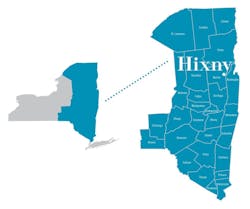A public opinion poll conducted recently by the Loudonville, New York-based Siena College Research Institute showed that nearly 85 percent of adults in eastern New York expect their healthcare providers to share patient records. Nearly the same number of adults in the 1,000-resident sample expect their providers to use an electronic health information exchange (HIE), if one is available. The poll’s top-line results were announced in a Feb. 27 press release.
The poll was sponsored by Hixny, the HIE of New York, which provides health information exchange across 28 counties in eastern New York state, north of New York City. The poll also found that “Seventy-five percent of adults consult their providers for information about both their specific health conditions and about any developments that affect their healthcare. That equals the combined number who consult friends and relatives, magazines and social media for general healthcare information.”
As the Feb. 27 press release noted, “Hixny funded the study after conducting a literature review of information gathered by HIEs around the country and finding that few, if any, had reported statistically significant results. Most polls and surveys had also been conducted before the sponsoring HIEs were fully operational.” And it quoted Hixny CEO Mark McKinney as saying that "We wanted to understand where the people we serve stand on issues related to electronic health information exchange right now. The results of the Siena poll are striking,” McKinney said in a statement in the press release. “The acceptance of electronic data sharing among the general population is very clear. The healthcare community needs to take action to satisfy those consumer expectations that a patient's data is available immediately at every point of care."
Following publication of the poll’s results, Hixny facilitated an interview between Healthcare Innovation Editor-in-Chief Mark Hagland and an active user of Hixny’s services. Julie Demaree, P.A. is a physician assistant and is the clinical informatics and documentation specialist at Saratoga Hospital Medical Group, a 200-physician medical group affiliated with Saratoga Hospital. Below are excerpts from Hagland’s interview with Demaree.
Tell me about your connection to Hixny.
We utilize Hixny quite a lot; Hixny is our health information exchange. And I’ve been a utilizer of our HIE for ten years. I’ve been a part of Saratoga Hospital for 18 years and in medicine for 20 years. So I was really interested to know that consumers are expecting us to share information. Physicians have been forced to adopt EHRs [electronic health records] and to use EHRs to supply information around quality and meaningful use. But we weren’t necessarily aware that our patients were expecting us to share information. We know that when they have surgery and follow up with the doctor, they expect that we have all the same information.
And one of the challenges with growth is that we don’t all have the same information. And the only way we’ve been able to do that in our organization has been through a health information exchange. We utilize that a lot, to be able to go to one source and gather information from all of our regional hospitals, make sure we don’t need to repeat tests or chase a lot of paper. So it was eye-opening for me to see that it was an expectation on the part of patients that we’re sharing that information.
Is it your perception that patients know what health information exchange is?
No, I don’t think that they do. They know they’ve been watching their providers transition to computers over the last numerous years, and know that computers should be able to share information. I don’t think they realize how complex that is, or how complex the privacy issues are. And I don’t think that patients take a very active role in HIE specifically. They’re becoming more and more engaged with patient portals. The problem for patients is that they need to log into each of your providers’ portals, with all their log-ins, etc. And as a patient, that really makes you responsible for your own health record, and you have to download information. You can send information into it and can tell doctors what to put into it, but you’re not necessarily sharing information directly. I think what people need to understand about an HIE is the opportunity really share information more broadly; and it’s an opportunity to make sure that information is correct. The truth is that information has been shared for decades about patients; patients just didn’t have that much access to it. But now you can see that information on the HIE, where you can see test results, lab results, diagnoses; and if there’s medication information that’s incorrect, it can be corrected.
Will the population health context change the landscape around HIE?
We’re already using those tools, and the information in my EHR already allows me to engage patients through the patient portal, saying, you’re due for a mammogram, and here’s some education. So we can engage people that way. I also get information about people from my own organization. However, I can log into the HIE and run a report on all of our patients, and sort information around ER visits, to find out who’s had the most and the least ER visits in the last six months. That’s population health. There isn’t just one ER. We’re in a suburban area, we have maybe 10 ERs patients may be going to. In an urban area, it could be dozens. Maybe patients are going to multiple ERs regularly. Maybe they’re not getting the information they need, or maybe they’re seeking medications. So the information going into have to be made available across the entire continuum of care, and multiple organizations, at the same time.
What do you think CIOs, CMIOs, and other healthcare IT leaders should be doing, around all of this?
It sounds obvious, but one of the most important things to me about HIEs is that they’re only as valuable as what we’re all contributing. I was an early adopter of our HIE, and we would go into it and were kind of disappointed with what we’d find. We loved the information, but wouldn’t find a lot of valuable information. Most organizations are sending lab and radiology results. But now, we send every single physician note—cardiology, nephrology, neurology—into our HIE—so when someone shows up in the ER, clinicians now have access to all those notes, as well as to diagnostic tests like EKGs. We also upload advanced directives. The CCDs sent to HIEs tell you that the person has an advanced directive on file or has had an EKG.
But what is really needed is information that’s usable. That’s what needs to be in there; it needs to have the things we need to have, to help make decisions. I also think it’s really important that everybody who’s contributing really take a lot of pride in the information they’re contributing, because it’s only as good as what people are sending into it. We sometimes do get information—because the structured data is uniform, but we can sometimes get med lists that are outdated from other practices. There can be information that just isn’t true. And it’s important that everyone be sharing good information. We want everybody’s information, but not everyone is at the same level of development. We need everybody to contribute, down to the smallest practices. But some need support to preserve data integrity.
And one of our biggest challenges is, how do we fix things when we see something that’s wrong. We see something that says something, and we know that that patient just doesn’t have the diagnosis, for example. Or on a claim, it says the patient is diabetic and they’re not. Now that it’s all out there, I hope that perhaps through insurance modifiers or something like that, there will be a process in the next few years for us to be able to amend data, so if someone puts garbage in, they can take the garbage aback out.
What should policy leaders know about this discussion?
I think that we probably need to look at the data-sharing. I think that it’s so important to where we’re going. I think that the way that the data is being used is going to continue to grow, and I think that it’s growing so fast that we probably need to be looking … In our area, for example, our payers are starting to use our HIE to close gaps, and that is so exciting for us, because there’s a financial gain to us without their having to go in and look at our records; and claims data will be in there. In NY state, data is sent to the HIE, and patients have to give consent for clinicians and others to look at their data; in other states, it’s opt-out. It’s going to be hard for us to get to the point of sharing data across state lines and other networks like Carequality, because there isn’t consistency around permissions; the rules are inconsistent, and there are certain practices straddling state lines, for whom the varied opt-in/opt-out rules are paralyzing, since they’re so different, state to state. Who can access data, how, and how patients can get data amended inside the HIEs, are all important issues.
Is there anything that you’d like to add?
I think, really, what this whole survey has done, is given us a lot of information that it’s OK that we share the data. I think we have been a little bit afraid that patients thought this was a Big Brother; and apparently not. They’re expecting this. Eighty-five percent of people are expecting this; and I was really shocked that they really were wanting us to use HIXNY. I love HIXNY. But I think we could do a better job of educating patients about this, nationwide. When I talk to other informaticists, etc., they don’t know about RHIOs in their area. I think it’s something that can and should be leveraged, and for organizations like ours that are combining and collaborating with others, rather than the solution for interoperability being that you all have to get on the same platform, sharing data through an HIE, rather than changing all your systems, is just such a smart option.


